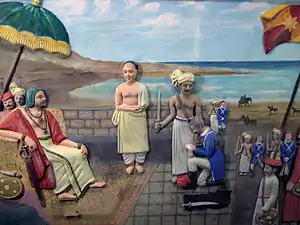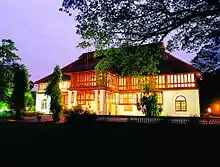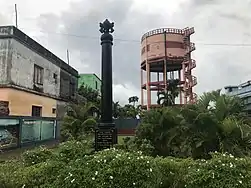Battle of Colachel
The Battle of Colachel (or Battle of Kulachal) was fought on 10 August 1741 [O.S. 31 July 1741][2][3] between the Indian kingdom of Travancore and the Dutch East India Company, during the Travancore-Dutch War. King Marthanda Varma's (1729–1758) forces defeated the Dutch East India Company's forces led by Admiral Eustachius De Lannoy on 10 August 1741. It was the first time in Indian history that an Asian country defeated a European naval force. The Dutch never recovered from the defeat and no longer posed a large colonial threat to India.[4]
| Battle of Colachel | |||||||
|---|---|---|---|---|---|---|---|
| Part of the Travancore-Dutch War | |||||||
 Eustachius De Lannoy's surrender at the Battle of Colachel | |||||||
| |||||||
| Belligerents | |||||||
|
|
| ||||||
| Commanders and leaders | |||||||
|
Marthanda Varma Thanu Pillai | Eustachius De Lannoy | ||||||
| Strength | |||||||
| 12,000-15,000 soldiers | 6000 soldiers, including 2,400 Europeans[1] | ||||||
| Casualties and losses | |||||||
| Travancore Army, Nair Brigade | 24 officers, including Eustachius De Lannoy, firearms and artillery captured | ||||||
| Part of a series on the |
| History of Kerala |
|---|
 |
|
Background
In the early 18th century, the Malabar Coast region of present-day Kerala was divided among several small chiefdoms. In the 1730s, Marthanda Varma, the ruler of Travancore, adopted an expansionist policy, and conquered several territories from these small states. This threatened the interests of the Dutch East India Company's command at Malabar, whose spice trade depended on procurement of spices from these states.[5] Marthanda Varma and his vassals refused to honour the monopoly contracts that the Dutch had with the states annexed by Travancore, adversely affecting the Dutch trade in Malabar.[6]
In January 1739, Gustaaf Willem van Imhoff, the Dutch Governor of Ceylon, visited Kochi, and in a July report, he recommended military action to save the Dutch business in Malabar.[7] Later that year, the Dutch organised an alliance of the rulers of Kochi, Thekkumkur, Vadakkumkur, Purakkad, Kollam, and Kayamkulam.[8] Van Imhoff personally met Marthanda Varma to negotiate peace, threatening to wage war against Travancore if the Dutch terms were not accepted, but Marthanda Varma dismissed the threat, and replied that he had been thinking about invading Europe some day.[9][7]
In late 1739, the Dutch command at Malabar declared war on Travancore, without obtaining permission or waiting for reinforcements from Batavia.[10] The Dutch deployed a detachment of soldiers from Ceylon against Travancore, under the command of Captain Johannes Hackert. They and their allies achieved several military successes in the initial campaign. In November, the allied army forced the Travancore army stationed near Kollam to retreat, and advanced up to Tangasseri.[11] The British East India Company chief at Anchuthengu congratulated the Dutch on their victory, and requested them to leave their establishment at Edava in peace.[12] Later, they also sent 150 soldiers to the Dutch.[13]
By early December, the Dutch and their allies marched towards Attingal and Varkala.[12] When the Travancore army withdrew to check an invasion by Chanda Sahib of Arcot in the south, the allies achieved further military successes.[7][14] However, the Dutch decided to wait for reinforcements from Ceylon before waging further war against Travancore.[7]
The Dutch wanted to take advantage of this situation, but they were unable to receive reinforcements from Batavia because of the riots there.[15] In November 1740, the Dutch command in Malabar received two small reinforcements of 105 and 70 soldiers from Ceylon, and launched a second campaign against Travancore, resulting in the battle of Colachel.[15]
Dutch occupation of Colachel
On 26 November, the Dutch sent two large ships and three sloops to Colachel (Kuḷaccal), bombarding the coast. Marthanda Varma sent 2,000 soldiers of Nair Brigade to Colachel.[15][16] On 29 November, the Dutch commander van Gollenesse announced a complete blockade of the Travancore coast around Colachel, directing his forces to seize all ships bound for the coast, with the exception of the English ships carrying goods to Edava.[15] Meanwhile, the Dutch forces captured Vadakkumkur. On 13 January 1741, the Dutch ship Maarseveen was sent southwards, to be anchored between Thengapattanam and Colachel.[15] The Dutch intended to occupy Colachel with an objective of attacking Padmanabhapuram, the capital of Travancore.[17]
On 10 February, a Dutch expedition comprising seven large ships and several smaller vessels landed just north of Colachel. According to some accounts the local mukkuvar population lined up at the shore with oars on their shoulders. From a distance it appeared as if these people were armed and dangerous. The fishermen managed to check the Dutch advance temporarily. However the Dutch succeeded in taking Colachel forcing the fishing population to flee inland.[18] After occupying Colachel, the Dutch set up stockades and stationed troops there. Subsequently, the Dutch forces started capturing the nearby villages, and marched towards Eraniel. They plundered and devastated the region between Colachel and Kottar, with van Gollenesse favouring the occupation of the entire region between Colachel and Kanyakumari.[19]
To effectively control the newly-conquered territories, the Dutch were expecting reinforcements to arrive from Ceylon and Batavia, but the Company Government at Batavia could not spare any reserve forces because of the Java War.[20] Faced with an acute shortage of Dutch soldiers in Malabar, Van Gollenesse requested at least 300-400 men from the Dutch Ceylon, and meanwhile, sent a section of the Dutch army to Kanyakumari to attack Travancore army from there.[21]
Siege of Colachel
Taking advantage of the shortage of troops faced by the Dutch, Marthanda Varma gathered a large force to attack the Dutch.[21] His patrol boats cut off supplies to the Dutch garrison from the sea, and his forces also imposed a blockade on the landside.[22] On 27 May, he worshipped at the Adikesava Perumal Temple at Thiruvattar, consecrated his sword there, and marched to Colachel.[21] The Travancore army did not have any siege equipment, and therefore, Marthanda Varma intended to simply starve the Dutch garrison out.[22] His army, which outnumbered the Dutch force at Colachel, encircled the Dutch entrenchments from all sides.[21] The Dutch troops at Colachel numbered around 400 (of which only around 150 were European), while the Travancore army had 12,000-15,000 soldiers. Although Marthanda Varma suffered heavy loss of men and money, he did not withdraw the siege.[23]
Besides the blockade imposed by the Travancore forces, the adverse wind, floods and rough sea also prevented the Dutch from supplying ammunition and provisions to Colachel. The heavy rains made it hard for them to keep their gunpowder dry, and made their weapons unusable. [23] According to a 31 July report of the English factory at Anchuthengu noted that two Dutch sloops had been trying to land at Colachel for several days, but had failed to do so because of continual fire from the Travancore forces.[22]
The personal diary of a man named Theuniz, which he had found among the Dutch East India records. Theuniz, who was on the Dutch ship called Porca, watched as the Travancore army,[24] armed by the British then stationed in Anchuthengu (near Attingal), bombarded the makeshift tent near the shore where the Dutch had gathered all their ammunition. That one big explosion ended the war on 10 August.(De Lannoy's research text from the University of Leiden in Netherlands.[25]
Surrender of the Dutch
On 5 August, a cannonball fired by the Travancore army fell into a barrel of gunpowder inside the Dutch garrison, and the resulting fire destroyed the entire rice supply of the stockade. Consequently, the Dutch were forced to surrender on 7 August.[22][26] While the Dutch records mention the date of the surrender as 7 August, some later sources give different dates for the Dutch surrender:[27]
- 31 July 1741 (31 Āḍi 916 ME) according to P. Shungoonny Menon A History of Travancore,[22] and T. K. Velu Pillai's Travancore State Manual Volume II.[28]
- 31 July 1741 (15 Karkadakam 916 ME) according to V. Nagam Aiya's Travancore State Manual Volume I. Aiya's conversion of the ME date to CE is wrong: the correct corresponding date would be 15 July 1741.[28]
- 10 August 1741 K. M. Panikkar's A History of Kerala.[28]
The court chronicle (Rajyakaryam Churuna) of Marthanda Varma simply states the date as Āḍi 916 ME, without mentioning any specific day. Historian A. P. Ibrahim Kunju takes the Dutch date (7 August 1741 CE) to be correct.[28]
The Dutch soldiers at Colachel surrender on the condition that they would be allowed to go to Kanyakumari with their weapons. However, Marthanda Varma did not honour the agreement, and imprisoned them as soon as they came out of the fort.[29] The Travancore forces captured a large number of muskets and some cannons from the Dutch garrison at Colachel. They imprisoned 24 Europeans and several native Christians, who were imprisoned at the Udayagiri Fort in Puliyoorkurichi.[28][30] Later, Marthanda Varma gave them their weapons back, and asked them to join the Travancore army.[29] Several European prisoners, including Eustachius De Lannoy and Duyvenschot, accepted the offer and served Marthanda Varma.[28] It was the first time in Indian history that an Asian country defeated a European naval force. Twenty-eight high level Dutch officers, including Admiral D'lennoy, were captured. The defeat of the Dutch in Colachael was the turning point of the Travancore-Dutch War. D'lennoy went on to serve the Travancore kingdom for the next two decades and was promoted to the post of the Valiya kappithan (Senior Admiral) of the Travancore forces. He modernised the Travancore army, and built the Nedumkottai, a line of fortifications in the north of the kingdom, which held up the army of Tipu Sultan in 1791, during his ill-fated invasion of Travancore. D'lennoy is buried in the Udayagiri Fort, also known as Dillanai kottai (D'lennoy's fort) https://www.thehindu.com/news/national/tamil-nadu/conservation-work-just-in-time-saves-udayagiri-fort/article32786736.ece
Impact
The historians of Travancore glorified the battle of Colachel as a decisive and crushing defeat for the Dutch.[28][29] The contemporary English records branded Travancore's victory at Colachel as a small military affair, and stated that the Travancore soldiers defeated a much smaller Dutch force that suffered from adverse weather and a misfortunate fire that destroyed their food provisions.[31] Historian M. O. Koshy notes that although the confrontation is popularly referred to as "Battle of Colachel" in several books, there was no continuous exchange of gunfire at Colachel: the Tranvancore army besieged the Dutch garrison, and after an accidental shot destroyed the Dutch provisions, the Dutch were forced to surrender.[32]
The Dutch threat to Travancore was not completely eliminated after Marthanda Varma's success at Colachel, as is evident by the fact that the Dutch continued to wage war against Travancore in the northern Malabar. They also maintained their position at Kanyakumari, hoping to receive reinforcements from Ceylon.[28] However, a 5,000-strong army dispatched by Marthanda Varma prevented them from advancing towards the capital of Travancore.[23] They also sent 150 soldiers to reinforce their advance posts at Paravur and Ayiroor. The Dutch gave up their position at Kanyakumari only in October. They also abandoned Attingal, after the soldiers of their ally Deshinganad abandoned them.[33]
Travancore's victory at Colachel greatly had decreased the Dutch morale, and in a 26 October report to Batavia, the Dutch command at Kochi mentioned that the native chiefs now believed that the Dutch East India Company could be driven off the Malabar coast.[28] However, by February 1742, the Dutch had captured a small fort near Attingal.[34]
In addition to the destruction of the Dutch East India Company's designs in the Malabar coast, the capture of the leaders of the expedition, Eustachius De Lannoy and his second in command Donadi, was very beneficial to the kingdom of Travancore. When De Lannoy and Donadi were paroled, they took up service with Travancore and modernized the Travancore Army (which, till then, had been armed mainly with melee weapons) into an effective fighting force. De Lannoy was initially entrusted with the training of a few companies of the Maharajah's bodyguards and he did this with such an excellence that he was entrusted with modernizing the entire Travancore army.[24] De Lennoy modernized the existing firearms and introduced better artillery and, more importantly, trained the Travancore army in the European style of military drill and military tactics. He carried out his orders with such sincerity and devotion that he rapidly rose through the ranks, eventually becoming the "Valia Kapitaan" (Commander in Chief) of the Tranvancore military and was given the Udayagiri Fort, locally known as the "Dillanai kotta" (De Lennoy's fort), near Padmanabhapuram, to reside. He was one of the commanders of the Tranvancore army during the decisive battle of Ambalapuzha where his erstwhile employers were fighting on behalf of Cochin and her allies. Following Travancore's victory over Cochin and her allies, the Dutch signed a peace treaty with Travancore and later sold their forts which were incorporated by De Lannoy into the Northern Lines (the Nedumkotta) that guarded the northern border of Travancore. The Travancore military that De Lannoy was instrumental in modernizing, went on to conquer more than half of the modern state of Kerala, and the Nedumkotta forts De Lannoy had designed, held up the advance of Tipu Sultan's French trained army during the Third Anglo-Mysore War in 1791 AD till the British East India Company joined the war in support of Travancore. Donadi ended up as an officer in the Travancore army and it seems that the rest of the Dutch prisoners took up service with the Maharajah's forces and their descendants were present up to 1878 in Travancore.[35]
Another direct outcome of the event at Kulachal was the takeover of the black pepper trade by the state of Travancore. This development was to have serious repercussions on the Dutch and the trading world of Kerala at large. In 1753 the Dutch signed the Treaty of Mavelikkara with the Dutch agreeing not to obstruct the Raja's expansion, and in turn, to sell to him arms and ammunition. This marked the beginning of the end of Dutch influence in India. The VOC (Vereenigde Oostindische Compagnie, or the Dutch East India Company) continued to sell Indonesian spices and sugar in Kerala until 1795, at which time the East India Company defeated of the Kingdom of Kochi and ended their rule in India.
Tributes

- The Indian government has built a pillar of victory in Kulachal to commemorate the event.
- The Indian Post Department released a Rupee 5 stamp on 1 April 2004 to commemorate the tercentenary (300th anniversary) of the raising of the 9th Battalion of Madras Regiment.
- The Parade Ground of Pangode Military Camp is named as Kulachal Ground.
See also
References
- http://employmentnews.gov.in/NewEmp/MoreContentNew.aspx?n=SpecialContent&k=90
- Ministry of Defence, Newsletter "Sainik Samachar", 15 April 2004
- The Hindu, "Army celebrates anniversary of Colachel battle", 31 July 2010
- M. O. Koshy (1989). The Dutch Power in Kerala, 1729-1758. Mittal Publications. pp. 70–. ISBN 978-81-7099-136-6.
- A. P. Ibrahim Kunju 1975, p. 375.
- M. O. Koshy 1989, pp. 58-59.
- A. P. Ibrahim Kunju 1975, p. 376.
- M. O. Koshy 1989, p. 60.
- M. O. Koshy 1989, p. 61.
- M. O. Koshy 1989, pp. 61-62.
- M. O. Koshy 1989, pp. 62-63.
- M. O. Koshy 1989, p. 63.
- M. O. Koshy 1989, p. 65.
- M. O. Koshy 1989, pp. 64-65.
- M. O. Koshy 1989, p. 66.
- pages 136-137,A history of Travancore from earliest times, P. Shungoony Menon, 1878, published by Higginbothams and Co, Madras
- M. O. Koshy 1989, pp. 66-67.
- Ajantha Subramanian (2009). Shorelines: Space and Rights in South India. Stanford University Press. pp. 46–. ISBN 978-0-8047-6146-8.
- M. O. Koshy 1989, p. 67.
- M. O. Koshy 1989, pp. 67-68.
- M. O. Koshy 1989, p. 68.
- A. P. Ibrahim Kunju 1975, p. 377.
- M. O. Koshy 1989, p. 69.
- pages 136-137, A history of Travancore from earliest times, P. Shungoony Menon, 1878, published by Higginbothams and Co, Madras
- {The Lannoy's research text from the University of Leiden in Netherlands}
- M. O. Koshy 1989, pp. 69-70.
- A. P. Ibrahim Kunju 1975, pp. 377-378.
- A. P. Ibrahim Kunju 1975, p. 378.
- M. O. Koshy 1989, p. 70.
- A survey of Kerala History, by Prof A. Sreedhara Menon, published by Viswanathan publishers, Madras, 1996, pp287
- M. O. Koshy 1989, pp. 70-71.
- M. O. Koshy 1989, p. 71.
- A. P. Ibrahim Kunju 1975, p. 379.
- M. O. Koshy 1989, p. 73.
- pages 136, A history of Travancore from earliest times, P. Shungoony Menon, 1878, published by Higginbothams and Co, Madras
Bibliography
- A. P. Ibrahim Kunju (1975). T. K. Ravindran (ed.). "The Battle of Kuḷaccal (1741) and the defeat of Dutch on the Malabar Coast". Journal of Kerala Studies. University of Kerala. 2 (3): 375–386.CS1 maint: ref=harv (link)
- M. O. Koshy (1989). The Dutch Power in Kerala, 1729-1758. Mittal Publications. ISBN 978-81-7099-136-6.CS1 maint: ref=harv (link)
Further reading
- Iyer, Dr. S. Krishna. Travancore-Dutch Relations, Nagercoil: CBH Publications, 1994, 164 pgs. ISBN 81-85381-42-9
- Menor, Sheela. Military History of Travancore with special reference to the Nayar Brigade, Ethiraj College for Women, 1995
- Menon, Dr. Sreedhara. A survey of Kerala history, S. Viswanathan Printers and Publishers, 1996.
- http://www.hindu.com/yw/2004/07/24/stories/2004072401210200.htm
- http://www.hindu.com/2010/08/01/stories/2010080154870200.htm
